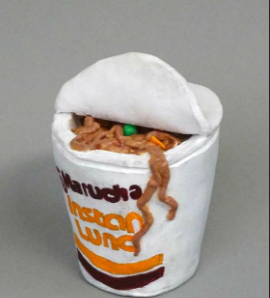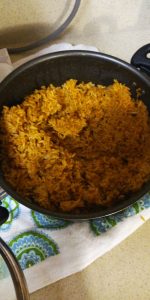Chinese people have many traditions when it comes to preparing and making food. There is a long history in China for preparing dishes for specific events like longevity noodles for birthdays and health remedies like seafood noodles (Zhang, 2016). Chinese people have specific traditions like shared dining which is very different from Western ways of dining and tend to share food out of the same plate( Junru, 2011). The Chinese believe in having a balanced diet and therefore they prepare traditional foods that are high in fiber and low in saturated fats (Na, 2016). This includes carbohydrate staples such as rice, noodles, or steamed buns, as well as stir-fries and soups. Then usually at the end of a meal hot tea, fresh fruit, and nuts are served instead of sweets (Lv, 2004).
As China has become more industrialized there has been more international communication with Western countries like the U.S. which resulted in Chinese people being introduced to many Western food and food practices. Though China has Western food available, many people living in China still primarily choose to keep their traditional food and practices. As Chinese people immigrate into the U.S., many begin to change their food eating habits and practices. As they get more accustomed to American culture they begin to include more Western traditions into their culture. Eventually many begin to eat and make less of traditional Chinese food and eat more American food, though many older Chinese immigrants still try to maintain their traditional diets. Many Chinese immigrants in America change their food culture as a result of a change in the environment and resources. This change is especially reflected in first-generation and the second generation Chinese immigrants as they tend to eat more American food.
Several studies show the Chinese immigrants change their dietary habits. In a study by researchers at Stanford, they found that the dietary habits of North American Chinese are more similar to those of North American whites than to those of Chinese in China(Lee, 1994). In this study, it revealed that a change in the environment plays a huge role in dietary habits. In another study, it was found that “Chinese people who resided in the United States for a longer period of time shared a greater increase in their consumption frequencies of vegetables, fats/sweets, and sweet beverages” (Lv, 2004). Further Chinese people with better English proficiency had a greater increase in their consumption frequency of grains, fruits, meat/meat alternatives, and fats/sweets(Lv, 2004). This pattern of eating more fats/sweets, fruits, and grains is especially reflected at breakfast time. In an interview with Chinese immigrants, the researchers() found that many of the immigrant families ate Western breakfast, such as cereal, bread, bagels, and waffles, with milk or orange juice. Though some families still incorporate traditional Chinese breakfast foods, such as stewed spiced eggs, steamed buns, or porridge (Sun, 1999). A typical Chinese breakfast includes stuffed or plain steamed buns with a bowl of porridge (congee), a dish of pickled vegetables, wonton hot soup noodle, rice and stir-fried dishes(Junru, 2011). For lunch and dinner, dietary habits vary a lot more between families. Many would choose to eat out at an American restaurant or buy premade food to be made for lunch or dinner. In fact, “about a third of Chinese adult immigrants choose to eat out for lunch or dinner either eating Western food like salad, sandwiches, soup, and fast food or Asian restaurants” according to a survey(Sun, 1999). For children(first generation), a change in eating habits begins as they are exposed to Western culture outside of the house. Many children begin to like Western food and snacks after enrollment in American daycare, kindergarten, or school. Children would typically eat Western food provided by schools or would bring Western food such as sandwiches or mini-pizza. In an interview, one mother said, “After they went to . . . they started to like American food . . . As I said, they like to eat sandwiches, pizza, and this kind of food”(Sun, 1999). Based on the foods mentioned, Chinese adults and children change their dietary pattern as a result of immigrating to the U.S.
Specific foods that have the highest change as a result of Chinese immigrants new dietary habits include foods with fats and sodiums. A survey found that red meats and dairy products accounted for two-thirds of the saturated fat in the North American Chinese diet, while for the people living in China, pork was the main source of saturated fats (Lee, 1994). In daily life, the Chinese usually would have a balanced meal and do not consume excessive amounts of meat in each meal (Junru, 2011). Researchers at Stanford found that there was high consumption of beef for Chinese in the United States compared to that of Chinese in China (Lee, 1994). Many American foods have milk or cheese, such as mac and cheese, ice cream, nachos, so it is very common for people living in America to consume dairy. In a study focused on dairy consumption, they found that Chinese in China seldom consumed dairy products and similar findings of low intake of dairy products among elderly Chinese had also been reported (Xu, 2010). Though many people from China, especially elderly Chinese people, are not used to eating dairy products as a part of their main diet, many Chinese immigrants try to incorporate it in some way.
Another dietary pattern that changed for Chinese immigrants in America is that they consume Chinese food less often. In a survey, it was found that after immigration, Chinese Americans increased consumption frequency of all seven food groups (grains, vegetables, fruits, meat/meat alternatives, dairy products, fats/sweets, and beverages) of Western foods while consumption frequency of traditional Chinese foods decreased(Lv, 2004). Among Chinese immigrants, younger children were especially resistant to consuming Chinese food. “In a survey conducted by Sun and other researchers they found that “Ninety percent of the families in the sample had at least 1 child who was picky about vegetables, especially Chinese vegetables, and sometimes other food like Chinese noodles, dumplings, or steamed pork with anchovy” (Sun, 1999). When it comes to trying different food options, some of the children were willing to consider only new Western food and would not try different Chinese items. One mother stated, “It is easy for my kids to accept new Western dishes, but not easy for them to accept new Chinese dishes”(Lee, 1994). Though eventually, the children begin to accept some Chinese foods, many still prefer more American foods as some mothers from the study reported that their children were more flexible at older ages and started to like Chinese food.
There are many reasons why Chinese people change their dietary habits. These changes mainly have to do with a change in an environment and/or associating new foods with their traditional foods. In an interview asking if their eating habits changed since immigrating to the United States, the researchers found that over half (56.9%) reported yes. The main explanations provided for why this change occurred were not having time to prepare Chinese traditional foods (32.6%) and having limited access to traditional Chinese food (30.8%) (Lv, 2004). Since some traditional Chinese food is not readily available at nearby stores and supermarkets, many Chinese people have to choose alternative foods. In fact, some Chinese people noted when shopping at supermarkets most adults found limited vegetable variety in the US and therefore this limitation resulted in dropping certain Chinese dishes (Sun, 1999). Since it is hard to find Chinese ingredients in many of the stores and to find some of these dishes would take a long time, the frequency of grocery shopping significantly decreased from daily or several times per week to weekly after immigration. To find some of the ingredients for their traditional dishes, Chinese immigrants often had a hard time and therefore were forced to change eating habits.
Another reason could be that some dishes are similar to Chinese foods and therefore are adapted in immigrant diets. For example, while many immigrant adults tend to not eat Western food items, foods similar to Chinese food are more accepted. In an interview, one of the immigrant fathers said, “Everybody likes to eat pasta. It is similar to Chinese noodles. We always remember to cook this dish” (Sun, 1999). Therefore, it is easy to make dishes like these since there is not too big of a difference in making these dishes, so American foods similar to Chinese foods are easily adapted to their diet.
Another reason why many Chinese immigrants change their dietary habits could be because of financial reasons. Researchers Pan, Dixon, Himburg, & Huffman found that “Chinese students, after having immigrated to the United States, changed their dietary choices to consume more American-style fast food such as pizza, hamburgers, sandwiches, french fries, carbonated beverages, and dairy products. This change was attributed to the cheaper price of U.S. food compared to pricier Chinese food(Lv, 2004).” This shows that the environment that Chinese immigrants are in makes a difference as the same foods they would eat in China are more expensive, and if the higher prices are concerning to them, they would look for cheaper options.
Interest in experimental cooking also makes an impact on the change in dietary habits. There is evidence that learning of new healthy American food makes an impact on Chinese immigrant food choices. In a study, it was found that immigrant mothers were willing to change what was served at family dinners (Sun, 1999). Many of the mothers stated that they get tired of serving the same food, such as rice. Since rice is a staple food in many Chinese households, it is eaten very often and becomes monotonous and therefore Chinese people try to explore making new foods(Junru, 2011). This was different for immigrant fathers as they preferred not to change what they serve at family dinners. In an interview, a father explained his reasoning for not changing his diet, “I am used to our current diet. It is good. I don’t want to try new food items, because I am afraid they don’t taste good or I am not used to eating them”(Sun, 1999). Overall, in this case, it is primarily immigrant mothers who would be willing to change their dietary preferences because they want to experiment with other foods.
Though Chinese people immigrate to the US and begin to eat more Western food, there are certain foods and food habits that are maintained from their Chinese culture. Chinese immigrant parents typically have more preferences for Chinese food while their children tend to prefer Western food items. In an interview conducted by researchers at Pennsylvania State, they found that many parents did not like most Western dishes such as hot dogs and mac and cheese (Lv, 2004). In addition to that, another interview found that immigrant parents and their children, it was found that many of the children tended to change their eating habits and eats foods such as barbecue chicken and chicken nuggets while the adults abstain from eating such food items (Sun, 1999). Parents resistance to American foods and preference for traditional Chinese food is a likely reason why many Chinese dishes are still maintained in the diets of Chinese immigrants in America.
Fathers enforcement of traditional meals is another reason for the preservation of Chinese foods. Men are usually the head of households and tend to enforce traditional Chinese foods over Western foods. In a study of Chinese immigrants, they found that “even though many parents struggled to control children’s food choices, the father’s view of the importance of the Chinese dinner pattern had the most impact over the children’s preference for Western food” (Sun, 1999). The father’s power in determining the foods served at dinner is an important influence on the family dietary pattern and is one of the major determinants of how fast Western food is adopted into dinner. Mothers also play a significant role and if both parents resisted Western food the children’s demands would not be heard. Though mothers tend to be more sensitive to their children’s demands, only if the father changed his personal preferences and flexibility about meal choices were Western food items served to everyone at dinner(Sun, 1999). Since fathers are usually the main ones determining meal choices for families, they are part of the reason why certain Chinese dishes are maintained after immigration.
Changes in the environment from busier lifestyles to food availability have all been factors that contribute to the change in dietary habits and food practices among Chinese immigrants. Traditional Chinese food pattern provides less total fat, saturated fat, cholesterol, and calcium than the typical American dietary pattern(Sun, 1999). While American food typically has higher total fat and sodium since many of the food is highly processed and typically many foods are made excessive amounts of oil and butter. When Chinese immigrants move to the United States, they begin to slowly adopt eating typical American food. This is especially seen in children and young adults as they are exposed more to Western culture through school. For the adults, many of them either start to incorporate more Western dishes likely because their ingredients for Chinese food are limited, they learn of more Western dishes and are open to trying them or just do not have time to prepare traditional food. Over time through more exposure to Western culture, many Chinese immigrant families begin to prepare less Chinese dishes. Though living in the United States changes much of their dietary habits there are still traditions that remain constant. Many older Chinese(especially males) play a significant role in maintaining traditional dishes, either because of their preferences or to preserve traditional beliefs. This is important because many immigrants would not immediately immerse in the new culture and tend to stick with people of their own culture, therefore they would not typically change their dietary habits so drastically. Yet, for many Chinese people, they changed their eating habits significantly once immigrating to the United States. In conclusion, the environment is a significant driving force for the change in dietary habits among Chinese immigrants.




